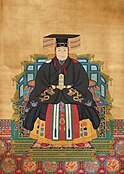
Back هانفو Arabic Hanfu BCL Hanfu Catalan Hanfu German Hanfu Esperanto Hanfu Spanish Hanfu Finnish Hanfu French 漢服 GAN Hanfu Hungarian
Hanfu (simplified Chinese: 汉服; traditional Chinese: 漢服; pinyin: Hànfú, lit. "Han clothing") are the traditional styles of clothing worn by the Han Chinese since the 2nd millennium BCE. There are several representative styles of hanfu, such as the ruqun (an upper-body garment with a long outer skirt), the aoqun (an upper-body garment with a long underskirt), the beizi and the shenyi,[1] and the shanku (an upper-body garment with ku trousers).[2]: 24
Traditionally, hanfu consists of a paofu robe, or a ru jacket worn as the upper garment with a qun skirt commonly worn as the lower garment. In addition to clothing, hanfu also includes several forms of accessories, such as headwear, footwear, belts, jewellery, yupei and handheld fans.[1] Nowadays, the hanfu is gaining recognition as the traditional clothing of the Han ethnic group, and has experienced a growing fashion revival among young Han Chinese people in China and in the overseas Chinese diaspora.[1][3][4][5]
After the Han dynasty, hanfu developed into a variety of styles using fabrics that encompassed a number of complex textile production techniques, particularly with rapid advancements in sericulture.[6] Hanfu has influenced the traditional clothing of many neighbouring cultures, including the Korean Hanbok,[7] the Japanese kimono (wafuku),[8][9] the Ryukyuan ryusou,[10][11] and the Vietnamese áo giao lĩnh (Vietnamese clothing).[12][13] Elements of hanfu design have also influenced Western fashion, especially through Chinoiserie fashion, due to the popularity of Chinoiserie since the 17th century in Europe and in the United States.[14]
- ^ a b c Wang, Xinyi; Colbert, François; Legoux, Renaud (2020). "From Niche Interest to Fashion Trend: Hanfu Clothing as a Rising Industry in China". International Journal of Arts Management. 23 (1). Retrieved 1 February 2021.
- ^ Steele, Valerie (1999). China chic : East meets West. John S. Major. New Haven: Yale University Press. ISBN 0-300-07930-3. OCLC 40135301.
- ^ China Daily (4 September 2019). "Hanfu market grows across China". China Daily. Retrieved 31 January 2021.
- ^ Zhang, Tianwei (25 November 2020). "Putting China's Traditional Hanfu on the World Stage". Women's Wear Daily [WWD]. Retrieved 1 February 2021.
- ^ Wright, Julia (17 August 2019). "Traditional Chinese clothing inspires a budding fashion in Saint John". CBC News. Retrieved 1 February 2021.
- ^ Cite error: The named reference
:27was invoked but never defined (see the help page). - ^ "National Museum of Korea: Quarterly Magazine, vol.47 by National Museum of Korea - Issuu". issuu.com. 20 May 2019. Retrieved 2 January 2024.
- ^ Stevens, Rebecca (1996). The kimono inspiration: art and art-to-wear in America. Pomegranate. pp. 131–142. ISBN 978-0-87654-598-0.
- ^ Dalby, Liza (2001). Kimono: Fashioning Culture. Washington, USA: University of Washington Press. pp. 25–32. ISBN 978-0-295-98155-0.
- ^ "Traditional Costume that Represents Okinawa's Culture and National Features, the "Ryusou". | Features | Okinawa Travel Info". okinawatravelinfo.com. Archived from the original on 7 July 2021. Retrieved 22 March 2021.
- ^ Nordquist, Barbara K. (1 January 1978). "The Ryūkyū Islands: Some Notes on Dress". Dress. 4 (1): 66–75. doi:10.1179/036121178805298829. ISSN 0361-2112.
- ^ 《大南實錄・正編・第一紀・世祖實錄》,越南阮朝,國史館
- ^ 《大南实录・正编・第一纪・卷五十四・嘉隆十五年七月条》,越南阮朝,國史館
- ^ Rovai, Serena (2016). Luxury the Chinese way : new competitive scenarios. Houndmills, Basingstoke, Hampshire. ISBN 978-1-137-53775-1. OCLC 946357865.
{{cite book}}: CS1 maint: location missing publisher (link)



